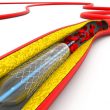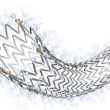Little is known about how good are our counseling efforts on medication use and lifestyle as regards patients with peripheral vascular disease. More often than not, we use our time with these patients to discuss the technical feasibility of rechanneling, or to analyze the risk of eventual amputation. However, how often do we seize the...
Plaque protrusion in carotid artery stenting: what are its risks and how can we prevent them?
Courtesy of Dr. Carlos Fava. Carotid artery stenting (CAS) has proven to be effective in high-risk patients. Nowadays, when performed by trained operators, its results are similar to those of surgery. This study seeks to clarify the incidence and prognosis of plaque protrusion through the stent (as observed in both control angiography and intravascular ultrasound [IVUS])...
Follow-up at 10 years for invasive vs. conservative strategy for non-ST-segment elevation infarction
The ICTUS (Invasive Versus Conservative Treatment in Unstable Coronary Syndromes) trial compared early invasive strategy with a selective invasive strategy in patients with non-ST-segment elevation acute coronary syndrome (NSTE-ACS), with elevated markers such as cardiac troponin T. The absence of long-term benefit of an early invasive strategy at 1 and 5 years had already been reported....
Dual antiaggregation time and death by bleeding
Despite the fact that some randomized studies and meta-analyzis have suggested prolonged dual antiaggregation could be associated to increased death rate, the underlying mechanism remains unclear. It is only logical to assume that if there was an actual increase in mortality associated to prolonged antiaggregation, this should be due to bleeding; however, no studies have...
Peripheral artery disease associated to ischemic and bleeding events after DES implantation
Patients with peripheral artery disease (PAD) have higher rates of cardiovascular events after DES implantation, which could be explained partly by higher platelet reactivity. The present work studies the relationship between platelet reactivity and clinical events after PCI in patients with and without a history of peripheral artery disease. The ADAPT-DES study (Assessment of...
Bioresorbable scaffolds with drug-eluting stents: do they entail a higher thrombosis risk?
Courtesy of Dr. Leiva. Bioresorbable scaffolds with drug-eluting stents (bioresorbable vascular scaffolds, BVS) have been added to the list of endovascular treatment options for coronary disease. The ABSORB III trial showed the non-inferiority of this stent type to everolimus-eluting metallic stents as regards target-lesion revascularization (TLR) at one year. However, reports have suggested a higher...
Percutaneous Mitral Annuloplasty: First Results in Humans
Courtesy of Dr. Agustín Vecchia. In the last few years, new percutaneous treatment options for mitral regurgitation have emerged. Transcatheter mitral annuloplasty with various devices is a relatively simple procedure that could compress the origin of circumflex artery branches due to the different orientation of mitral corners and the coronary sinus. The following work by Park...
New Generation of DES already being tested, so far safe
This study evaluated the safety and efficacy of the new drug eluting stents (Medtronic, Santa Rosa, California) to treat de novo coronary lesions. These new polymer free drug filled stents have the potential to improve clinical outcomes and allow a shorter dual antiplatelet therapy. In addition, they have been made with three layers of continuous...
See the Presentations of the 2016 Chile Sessions
We thank all the speakers of the Chile 2016 Sessions who shared their presentations to contribute to our mission of promoting the dissemination of information from research and clinical practice in Interventional Cardiology. You can read and/or download them below Lluberas, Ricardo. “Role of pharmacovasive therapy in the treatment of IAMcEST. Implications for Latin...
Anticoagulated Patients with Atrial Fibrillation Undergoing Angioplasty: How to Treat Them
In patients with atrial fibrillation undergoing coronary angioplasty with stents, standard anticoagulation with vitamin K antagonists plus dual antiplatelet therapy with a P2Y12 inhibitor and aspirin reduces the risk of stent thrombosis and stroke, but increases the risk of bleeding. The effectiveness and safety of anticoagulation with rivaroxaban plus one or two antiplatelet agents...









